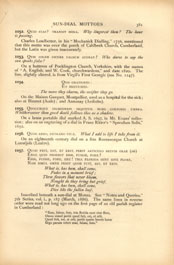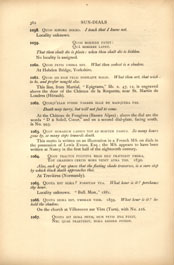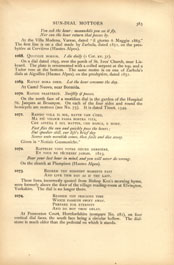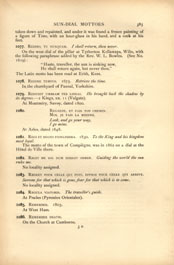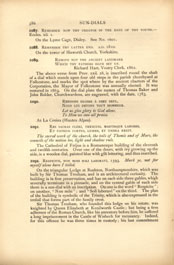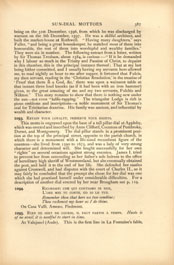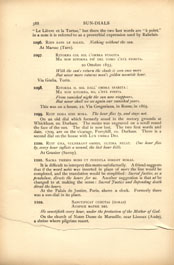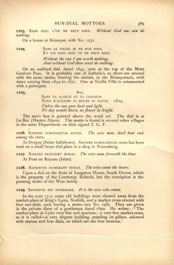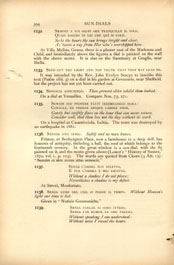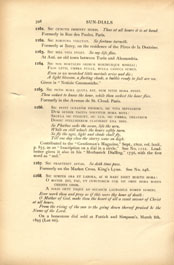Sun-Dial Mottoes (continued.)
| 1052. | QUID STAS? TRANSIT HORA. Why lingerest thou? The hour is passing. Charles Leadbetter, in his "Mechanick Dialling," 1756, mentioned that this motto was over the porch of Caldbeck Church, Cumberland, but the Latin was given inaccurately. |
| 1053. | QUIS SOLEM DICERE FALSUM AUDEAT? Who dares to say the sun speaks false? On a buttress of Pocklington Church, Yorkshire, with the names of "A. English, and W. Cook, churchwardens," and date 1820. The line, slightly altered, is from Virgil's First Georgic (see No. 1247). |
| 1054. | QUO GRATIORES: On the Maison Gasquet, Montpellier, used as a hospital for the sick; also at Bizanet (Aude); and Annonay (Ardèche). |
| 1055. | QUOCUNQUE INGREDERIS SEQUITUR MORS CORPORIS UMBRA. Whithersoever thou goest death follows thee as a shadow. On a brass portable dial marked A. S. 1697, in Mr. Evans' collection; also on an engraving of a dial in Franz Ritter's "Speculum Solis," 1652. |
| 1056. | QUOD ADDO, DETRAHO VITÆ. What I add to life I take from it. On an eighteenth century dial on a fine Romanesque Church at Lanuéjols (Lozère). |
| 1057. | QUOD FUIT, EST, ET ERIT, PERIT ARTICULO BREVIS ORAE (sic) Inscribed beneath a sun-dial at Monza. See "Notes and Queries," 7th Series, vol. i., p. 187 (March, 1886). The same lines in reverse order were read not long ago on the first page of an old parish register in Cumberland: "Esse, fuisse, fore, tria florida sunt sine flore, |
| 1058. | QUOD IGNORO DOCEO. I teach that I know not. Locality unknown. |
| 1059. | QUOD MORIERE PATET: That thou shalt die is plain: when thou shalt die is hidden. No locality is assigned. |
| 1060. | QUOD PETIS UMBRA EST. What thou seekest is a shadow. At Hebden Bridge, Yorkshire. |
| 1061. | QUOD SIS ESSE VELIS NIHILQUE MALIS. What thou art, that wish to be, and prefer nought else. This line, from Martial, "Epigrams," lib. x. 47, 12, is engraved above the door of the Château de la Roquette, near St. Martin de Londres (Hérault). |
| 1062. | QUOIQV'ELLE PVISSE TARDER ELLE NE MANQUERA PAS. Death may tarry, but will not fail to come. At the Château de Fougères (Basses Alpes); above the dial are the words "D + Soleil, Coeur," and on a second dial-plate, facing south, is No. 993. |
| 1063. | QUOT HORARUM LAPSUS TOT AD MORTEM PASSUS. So many hours gone by, so many steps towards death. This motto is written on an illustration in a French MS. on dials in the possession of Lewis Evans, Esq.; the MS. appears to have been written at Nancy in the first half of the eighteenth century. |
| 1064. | QUOT TRACTUS FUGITIVA MEOS HEU PRÆTERIT UMBRA, Alas, each of my spaces that the fleeting shade traverses, is a sure step by which black death approaches thee. At Trevières (Normandy). |
| 1065. | QUOTA EST HORA? FORSITAN TUA. What hour is it? perchance thy hour. Locality unknown. "Bull. Mon.," 1881. |
| 1066. | QUOTA HORA EST, UMBRAM VIDE. 1859. What hour is it? behold the shadow. On the church at Villeneuve sur Vère (Tarn), with No. 216. |
| 1067. | QUOTA SIT HORA PETIS, DUM PETIS IPSA FUGIT, |
You ask the hour: meanwhile you see it fly, At the Villa Modena, Varese, dated "il giorno 6 Maggio 1865." The first line is on a dial made by Zarbula, dated 1851, on the presbytère at Cervières (Hautes Alpes). |
|
| 1068. | QUOTIDIE MORIOR. I die daily (I Cor. xv. 31). On a dial dated 1695, over the porch of St. Ives' Church, near Liskeard. The plate is ornamented with a coiled serpent at the top, and a Tudor rose at the bottom. The same motto is on one of Zarbula's dials at Aiguilles (Hautes Alpes), on the presbytère, dated 1851. |
| 1069. | RAPIAT HORA DIEM. Let the hour consume the day. At Castel Nuevo, near Bormida. |
| 1070. | RAPIDE PRAETERIT. Swiftly it passes. On the north face of a meridian dial in the garden of the Hospital St. Jacques at Besançon. On each of the four sides and round the hemicycle are mottoes (see No. 75). It is dated Tissot, 1549. |
| 1071. | RAPIDO VOLA IL SOL, RATTE VAN L'ORE, Given in "Notizie Gnomoniche." |
| 1072. | RAPPELEZ VOUS VOTRE HEURE DERNIÈRE, Bear your last hour in mind, and you will never do wrong. On a church at Plampinet (Hautes Alpes). |
| 1073. | REDEEM THY MISSPENT MOMENTS PAST These lines, incorrectly quoted from Bishop Ken's morning hymn, were formerly above the door of the village reading-room at Elvington, Yorkshire. The dial is no longer there. |
| 1074. | REDEEM THY PRECIOUS TIME At Pennoxton Court, Herefordshire (compare No. 281), on four vertical dial faces, the south face being a circular hollow. The dial-stone is much older than the pedestal on which it stands. |
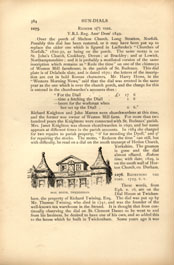
[Full Image]
DIAL HOUSE, TWICKENHAM
| 1075. |
REDEEMY Y(E) TIME.
Over the porch of Shelton Church, Long Stratton, Norfolk. Possibly this dial has been restored, or it may have been put up to replace the older one which is figured in Ladbroke's "Churches of Norfolk," 1820-30, as being on the porch. The same motto is on St. John's Church, Cookbury, Devon; at Brackley; and at Lowick, Northamptonshire; and it is probably a mutilated version of the same inscription which remains as "Rede the time" on one of the chimneys of Weston Mill farmhouse, in the parish of St. Budeaux. This dial plate is of Delabole slate, and is dated 1670; the letters of the inscription are cut in bold Roman characters. Mr. Harry Hems, in the "Western Morning News," said that the dial was erected in the same year as the one which is over the church porch, and the charge for this is entered in the churchwarden's accounts thus:
Richard Knighton and John Marten were churchwardens at this time, and the former was owner of Weston Mill farm. For more than two hundred years the Knightons were connected with St. Budeaux' parish. Mrs. Janet Knighton was chosen churchwarden in 1690, and her name appears at different times in the parish accounts. In 1684 she charged for two repairs to parish property, "6d for mending the Dyell," and 9d for repairing the stocks. The motto, "Redeem the time" can still, but with difficulty, be read on a dial on the south transept of Hedon Church, Yorkshire. The gnomon is gone and the dial almost effaced. Redeem time, with date, 1829, is on the south wall of Horton Church, co. Durham. |
||||||||||||
| 1076. | REDEEMING THE TIME. 1725. T. T. These words, from Eph. v. 16, are on the Dial House at Twickenham, the property of Richard Twining, Esq. The dial was put up by Mr. Thomas Twining, who died in 1741, and was the founder of the well-known tea warehouse in the Strand. It is thought that from continually observing the dial on St. Clement Danes as he went to and from his business, he desired to have one of his own, and so added this to the house which he built in Twickenham. Some years ago it was |
taken down and repainted, and under it was found a fresco painting of a figure of Time, with an hour-glass in his hand, and a cock at this feet. |
|
| 1077. | REDIBO, TU NUNQUAM. I shall return, thou never. On a the west dial of the pillar at Tytherton Kellaways, Wilts, with the following paraphrase added by the Rev. W. L. Bowles. (see No. 1619): "Haste, traveler, the sun is sinking now, The Latin motto has been read at Erith, Kent. |
| 1078. | REDIME TEMPUS. 1675. Retrieve the time. In the churchyard of Pannal, Yorkshire. |
| 1079. | REDUXIT UMBRAM PER LINEAS. He brought back the shadow by its degrees. – 2 Kings, xx. II (Vulgate). At Montméry, Savoy, dated 1800. |
| 1080. | REGARDE, ET FAIS TON CHEMIN. At Arles, dated 1848. |
| 1081. | REGI ET REGNO FIDELISSIMA. 1830. To the King and his kingdom most loyal. The motto of the town of Compiègne, was in 1862 on a dial at the Hôtel de Ville there. |
| 1082. | REGIT ME SOL DUM DIRIGIT ORBEM. Guiding the world the sun rules me. No locality assigned. |
| 1083. | REGRET POUR CELLE QUI FUIT, EFFROI POUR CELLE QUI ARRIVE. Sorrow for that which is gone, fear for that which is to come. No locality assigned. |
| 1084. | REGULA VIATORIS. The traveller's guide. At Prades (Pyrenées Orientales). |
| 1085. | REMEMBER. 1803. At West Ham. |
| 1086. | REMEMBER DEATH. On the church at Camborne. |
| 1087. | REMEMBER NOW THY CREATOR IN THE DAYS OF THY YOUTH – Eccles. xii. I. On the Lyme Cage, Disley. See No. 1601. |
| 1088. | REMEMBER THY LATTER END. A.D. 1810. On the tower of Haworth Church, Yorkshire. |
| 1089. | REMOVE NOT THE ANCIENT LANDMARK The above verse from Prov. xxii. 28, is inscribed round the shaft of a dial which stands upon four old steps in the parish churchyard at Folkestone, and marks the spot where by the ancient charters of the Corporation, the Mayor of Folkestone was annually elected. It was restored in 1863. On the dial plate the names of Thomas Baker and John Bolder, Churchwardens, are engraved, with the date, 1783. |
| 1090. | RENDONS GLOIRE À DIEU SEUL, At La Croiza (Hautes Alpes). |
| 1091. | RES SACRAS CLERI, THEMIDIS, MARTISQUE LABORES, The sacred work of the church, the toils of Themis and of Mars, the councils of the nation too, light and shadow rule. The Cathedral of Fréjus is a Romanesque building of the eleventh and twelfth centuries. Over one of the doors, with ivy growing up the side, is a wooden dial, painted blue with gilt lettering, and thus inscribed. |
| 1092. | RESPICITE, NON MIHI SOLI LABORAVI, 1593. Mark ye, not for myself alone have I toiled. On the triangular Lodge at Rushton, Northamptonshire, which was built by Sir Thomas Tresham, and is an architectural curiosity. The building is in fine preservation, and has on each side three gables, which severally terminate in a pinnacle, and on the central gable of each side there is a sun-dial with an inscription. On one is the word"Respicite"; on another, "Non mihi"; and "Soli laboravi" on the third. The plan of the building is symbolic of the Trinity, which is also expressed in the trefoil that forms part of the family crest. Sir Thomas Tresham, who founded this lodge on his estate, was knighted by Queen Elizabeth at Kenilworth Castle; but being a firm adherent of the Roman Church, like his ancestors before him, he suffered a long imprisonment in the Castle of Wisbech for recusancy. Indeed, for this offence he was three times in custody; his last commitment |
| being on the 31st December, 1596, from which he was discharged by warrant on the 8th December, 1597. He was a skilful architect, and built the market-house at Rothwell. "Having many daughters," says Fuller, "and being a great housekeeper, he matched most of them into honourable, the rest of them into worshipful and wealthy families." They were six in number. The following extract from a letter, written by Sir Thomas Tresham, about 1584, is curious: – "If it be demanded why I labour so much in the Trinity and Passion of Christ, to depaint in this chamber, this is the principal instance thereof; That at my last being hither committed, and I usually having my servants here allowed me, to read nightly an hour to me after supper, it fortuned that Fulcis, my then servant, reading in the 'Christian Resolution,' in the treatise of 'Proof that there is a God, &c.' there was upon a wainscot table at that instant three loud knocks (as if it had been with an iron hammer) given, to the great amazing of me and my two servants, Fulchis and Nilkton." This story remains to show that there is nothing new under the sun – not even "table-rapping." The triangular Lodge is rich in pious emblems and inscriptions – a noble monument of Sir Thomas's zeal for Trinitarian doctrine. His family was ancient, and influential by wealth and character. | |
| 1093. | RETAIN YOUR LOYALTY, PRESERVE YOUR RIGHTS. This motto is engraved upon the base of a tall pillar dial at Appleby, which was erected and inscribed by Anne Clifford, Countess of Pembroke, Dorset, and Montgomery. The dial pillar stands in a prominent position at the top of the principal street, opposite to the parish church, in which there is a monument with a life-sized recumbent figure of the countess – she lived from 1590 to 1675, and was a lady of very strong character and determined will. She fought successfully for her own "rights" on several occasions against strong enemies. James I. tried to prevent her from succeeding as her father's sole heiress to the office of hereditary high sheriff of Westmoreland, but she eventurally obtained the post, and held it to the end of her life. She defended her castles against Cromwell, and had disputes with the court of Charles II., so it may fairly be concluded that the precept she chose for her dial was one which she had practiced herself under considerable difficulties. For a description of another dial erected by her near Brougham see p. 119. |
| 1094. | RICORDATI CHE QUI CONTIAMO IN DUE, On Casa Valli, Ameno, Piedmont. |
| 1095. | REIN NE SERT DE COURIR, IL FAUT PARTIR À TEMPS. Haste is of no avail, it is needful to start in time. At Valajanel (Aude). This is the first line of La Fontaine's fable, |
| "Le Lièvre et la Tortue," but there the two last words are "à point," in a note it is referred to as a proverbial expression used by Rabelais. | |
| 1096. | RIEN SANS LE SOLEIL. Nothing without the sun. At Marsac (Tarn). |
| 1097. |
Via Giulia, Turin. |
| 1098. | RITORNA IL SOL DALL' OMBRA SPARITA: This was on a house, 22, Via Gregoriana, in Rome, in 1865. |
| 1099. | RUIT HORA SINE MORA. The hour flies by, and stays not. On an old dial which formerly stood in the rectory grounds at Whickham, co. Durham. The motto was engraved on a scroll round the face of the sun. The dial is now lost. The two first words and date, 1709, are on the vicarage, Ferryhill, co. Durham. There is a second dial on the house with LUX UMBRA DEI. |
| 1100. | RUIT UNA, VULNERANT OMNES, ULTIMA NECAT. One hour flies by, every hour inflicts a wound, the last hour kills. At Granier (Savoy). |
| 1101. | SACRA THEMIS MORS UT PENDULA DIRIGIT HORAS. It is difficult to interpret this motto satisfactorily. A friend suggests that if the word nobis was inserted in the place of mors the line would be completed, and the translation would be simplified: Sacred Justice, as a pendulum, directs the hours for us. Another suggestion is that ut be changed to et, making the sense: Sacred Justice and impending death direct the hours. At the Palais de Justice, Paris, above a clock. Formerly there was a sun-dial in its place. |
| 1102. | SANCTIFICAT CUNCTAS (HORAS) He sanctifieth every hour, under the protection of the Mother of God. On the church of Notre Dame de Marseille, near Limoux (Aude), a shrine where pilgrims resort. |
| 1103. | SANS DIEU L'ON NE PEUT RIEN. Without God one can do nothing. On a house at Briançon, with No. 1231. |
| 1104. | SANS LE SOLEIL JE NE SUIS RIEN. On an outlined dial, dated 1843, seen at the top of the Mont Genèvre Pass. It is probably one of Zarbula's, as there are several with the same motto, bearing his initials, in the Briançonnais, with dates varying from 1839 to 1871. One at Vieille Ville is ornamented with a parroquet. |
| 1105. |
The sun's face is painted above the word sol. The dial is at La Bez (Hautes Alpes). The motto is found in several other villages in the same Department, on dials signed Z. G. F. |
| 1106. | SAPIENS DOMINABITUR ASTRIS. The wise man shall bear rule among the stars. At Dergny (Seine Inférieure). SAPIENS DOMINABITUR ORBIS has been read on a small brass dial plate in a shop in Nuremberg. |
| 1107. | SAPIENS PRÆVIDET HORAS. The wise man foreseeth the time. At Pont en Royans (Isère). |
| 1108. | SAPIENTES NUMERANT HORAS. The wise count the hours. Upon a dial on the front of Langston House, South Devon, which is the property of the Courtenay Bulteels, but the inscription is the punning motto of the Wise family. |
| 1109. | SAPIENTIS EST NUMERARE. It is the wise who count. In the year 1710 some old buildings were cleared away from the market-place of King's Lynn, Norfolk, and a market cross erected with four sun-dials, each having a motto (see No. 248). They are given in the private diary of a gentleman, dated 1890. He writes: "The market-place at Lynn very fine and spacious; a very fine market cross, as it is called – a very elegant building, standing on pillars, adorned with statues and four dials, on which are the four mottoes." |
| 1110. | SCIO CUI CREDIDI. I know whom I have believed. (2 Tim. i. 12). At Albi (Tarn), in the garden of the Archbishop's Palace. The dial is horizontal, of white marble, and the motto is that of Archbishop Jean Paul Lyonnet, who died 1875. His arms are also engraved on the dial, and the date 1858. |
| 1111. | SCIS HORAS, NESCIS HORAM. Thou knowest the hours, thou knowest not the hour. On the convent at Cimiez, near Nice. See Nos. 233, 598, 1463, 1475, 1618. |
| 1112. | S' HAI VERTUDE E PACE IN CORE If thou hast virtue and peace in thy heart, At Villa Gamberini, Mazza Cozzile, Italy. |
| 1113. |
These inscriptions are the mottoes on three separate dials, which are placed on the sides of the Tower of the Campanile at Trafiume, near Canobbio, on the Lago Maggiore. Near the top of the tower is the date thus given: "Anno Domini MDCCCVIII Ristaurato nel 1808. |
| Capo Maestro Andrea de Bernardi." Each verse is written below its respective dial. We may assume that there were dials before the year named. | |
| 1114. |
Was read somewhere on the route between Florence and Bologna. |
| 1115. | SE IL SOLE CO' SUOI RAGGI ME PERCUOTE Given in "Notizie Gnomoniche." |
| 1116. | SE IL SOLE MI GUARDA OGNUN MI LODA E STIMA. Given in "Notizie Gnomoniche." |
| 1117. | SE IL SOLE NON SI VEDE, On a house at Alagna. |
| 1118. | SE IO SONO OMBRA E COL SOL MI NASCONDO: On the Oratory of Sta. Marta at Pavone Canavese, prov. of Turin. See Nos. 1435 and 1436. |
| 1119. | SE ME MIRAS, ME MIRAN. If thou lookest at me, they look at me. Seen in Spain and also on the Mairie at Cablas (Pyrenées Orientales). The dial speaks to the sun, of men. Compare No. 73. |
| 1120. | SE NON E QUESTA, QUELLA. If not this hour, well then! the next. Formerly on the Convent of the Théatins, Paris. See No. 1004. |
| 1121. | SE NON RILUCE IL SOL, NESSUN MI GUARDA. If no sun shines, none looks on me. Given in "Notizie Gnomoniche." |
| 1122. |
Inscribed round the circle of hours, on a slate dial face, at Ballakilley, in the parish of Rushen, Isle of Man. On referring to No. 1166 it will be seen that the lines are identical with an "Inscription on a sun-dial in a circle," which was published in the "Gentleman's Magazine," September 1802. There, however, the first two lines are those which the Ballakilley motto are placed last. It seems probable that the maker of the Manx dial in 1830 copied the inscription from the "Gentleman's Magazine," and was a better mathematician than scholar, since he treated the Latin and Greek mottoes in a very reckless fashion. The word sensim
was omitted, thereby preventing the fourth line from scanning, and clauserit
written as two words – claus erit.
There is a motto at each corner of the plate –
|
| 1123. | SED FUGIT INTEREA, FUGIT IRREPARABILE TEMPUS, These lines from Virgil, Georg. III. 284-285, were placed by Mr. Devaston on a house dial at West Felton, Salop. |
| 1124. | SEE, AND BE GONE ABOUT YOUR BUSINESS. On a dial over the south porch of Chesterton Church, county Warwick. |
| 1125. | SEE THE LITTLE DAY-STAR MOVING |
SEIZE AND USE THEM Mr. Howard Hopley recorded this motto without naming any locality and added, "The little day-star was a spot of light falling through a hole in the pointer to indicate the hour" ("Leisure Hour," June, 1870). The lines are also given by Leadbetter in his "Mechanick Dialling," 1756. |
|
| 1126. | SEEK YE THE LORD WHILE HE MAY BE FOUND (Isaiah, lv. 6). On the south-west porch of Mattishall Church, Norfolk dated 1857, and probably a restoration of the older dial, figured in Mr. Ladbrooke's "Churches of Norfolk," 1825-30. The motto is also at Cains Cross, near Stroud, with No. 95. |
| 1127. | SEGNANDO I PASSI AL SOL L'OMBRA FUGACE, On a house at Castel Lavazzo, near Longarone. This was the "pagus Labactantius" of Roman times, where there was a horologium or sun-dial in the time of the Empire. |
| 1128. | SEGNO A CAMPANA, E LA CAMPANA ANCORA Given in "Notizie Gnomoniche." |
| 1129. | SEGNO LE ORE SÌ, MA NON PIÙ QUELLE. I mark the hours, 'tis true, but no longer those gone by. On a farmhouse in the neighbourhood of Lari, Tuscany, and noted by Mrs. Janet Ross in "Macmillan's Magazine." |
| 1130. | SEGNO SOLO LE ORE SERENE. I mark only the bright hours. On a wall of the back of Villa Novello, at Genoa. A bank separates the house from the sea, which it faces, and is luxuriantly covered with aloes, prickly pear, and other plants so familiar along the Riviera. |
| 1131. | SEMITAM, PER QUAM NON REVERTAR, AMBULO. I shall go the way whence I shall not return (Job, xvi. 22). On the wall of the church at Lavagna on the Riviera di Levante. Lavagna lies between Chiavari and Sestri Levante. It formerly belonged, together with the greater part of the east coast, to the Fieschi of Genoa, who bore the title of Counts of Lavagna. The dial is beside the great door of the church, to which a flight of marble steps leads up, and which faces the sea. |
| 1132. |
At Villa Mylius, Genoa, there is a plaster cast of the Madonna and Child, and immediately above the figures a dial is painted on the wall with the above motto. It is also on the Sanctuary at Graglia, near Biella. |
| 1133. | SEND OUT THY LIGHT AND THY TRUTH THAT THEY MAY LEAD ME. It was intended by the Rev. John Evelyn Stacye to inscribe this text (Psalm xliii. 3) on a dial in his garden at Grenoside, near Sheffield, but the project has not yet been carried out. |
| 1134. | SENESCIS ASPICIENDO. Thou growest older whilst thou lookest. |
| 1135. | SENSIM SED PROPERE FLUIT IRREMEABILIS HORA: On a hospital at Casamicciola, Ischia. The town was destroyed by an earthquake in 1881. |
| 1136. | SENSIM SINE SENSU. Softly and no man knows. Friston, or Bechyngton Place, now a farmhouse in a deep dell, has features of antiquity, including a hall, the roof of which belongs to the fourteenth century. In the great window is a sun-dial, with the fly painted on it, and the motto given above (Lower's "History of Sussex," 1870, vol. i., p. 103). The words are quoted from Cicero (3 Att. 15): "Sensim et sine sensu ætas senescit." |
| 1137. | SENZA L'OMBRA NON DILETTO, At Strevi, Monferrato. |
| 1138. | SENZA LUME DEL CIEL SI PERDE IL TEMPO. Without Heaven's light our time is lost. Given in "Notizie Gnomoniche." |
| 1139. | SENZA PARLAR IO SONO INTESO, |
On a wall by the roadside, near Pieve di Sori, Riviera di Levante; also at Sordevole in Piedmont; and at Bordighera. Dean Alford notes and translates this motto: "I speak not, yet all understand me well; A gentleman walking from Como to Monte Generoso observed at Balerna a slightly different version, which is also at Balmuccia, Val Sesia; and at Castasegna, Val Bregaglia. SENZA PARLAR DA TUTTI SON INTESO, |
|
| 1140. | SENZA SOLE IO RIPOSO. Without the sun I rest. Traced on the wall of the Albergo del Gatto, a wayside inn at Riva, Riviera di Ponente. |
| 1141. | SEPTEM SINE HORIS. Seven without the hours. The meaning of this bald inscription must be that there are in the longest days seven hours (and a trifle over) in which the dial is useless. The motto is on a dial declining west, erected on a gable at Packwood House, Warwickshire. See No. 934. |
| 1142. | SEPTIES IN DIE LAUDEM DIXI TIBI. Seven times a day do I praise thee. Ps. cxix. 164. Over the north door of the cathedral at Padua. |
| 1143. |
SERIUS EST QUAM COGITAS. At Sermérieu (Isère). The Latin is misspelt on the dial. |
| 1144. | SET ME RIGHT AND USE ME WELL, Is engraved on an old pocket dial which its owner thus describes: "It is a ring of brass, much like a miniature dog collar, and has, moving in a groove in its circumference, a narrower ring with a boss, pierced by a small hole to admit a ray of light. The latter ring is made moveable to allow for the varying declination of the sun in the several months of the year, and the initials of these are marked in ascending and descending scale on the larger ring which bears the motto. The hours are lined and numbered in the opposite concavity." A similar dial belonging to a cottager at Pelynt, Cornwall, is described and figured in the "The Reliquary." Mr. Lewis Evans has a ring, |
made by Procter, with a slightly different version of the above inscription; it is arranged thus:
|
|||||||||||
| 1145. | SHADOW AND SHINE IS LIFE. At Bramble Hill, in the New Forest. The quotation is from Tennyson's "Grandmother." "Shadow and shine is life, little Annie, flower and thorn." |
||||||||||
| 1146. | SHADOWS CAST UPON THE DIAL SHOW On a dial in Ovingdean churchyard, Sussex. |
||||||||||
| 1147. | SHADOWS WE ARE, AND On Pump Court, Temple; and at Menwith Hill, Darley, Yorkshire. See Nos. 468, 1530. |
||||||||||
| 1148. | SHINING SPOT FOR EVER SHINING Inscription for a "spot" dial, where the hour is shown by a ray of light instead of a shadow. Given by Charles Leadbetter, 1756. |
||||||||||
| 1149. | SHOW ME THE LIGHT OF THY COUNTENANCE. From Psalm lxxx. 7 is engraved below a handsome vertical dial, erected in 1883 at Abbeyfield, Sheffield, by Bernard Wake, Esq. Above the dial is No. 767. |
||||||||||
| 1150. | SI CETTE HEURE, CHRÉTIEN, N'EST CELLE DE LA MORT, On the church, La Garde (Isère). |
||||||||||
| 1151. | SI CULPARE VELIS, CULPABILIS ESSE CAVEBIS. At Moccas Court. See No. 1469. |
| 1152. | SI MEA VITA FUGIT. So my life flies. At Asti, Piedmont. |
| 1153. | SI MUORE. To all death comes. Near Nice. |
| 1154. | SI NESCIS, HOSPES, SUNT HIC ORACULA PHOEBI, Contributed by the Rev. R. F. Littledale, LL. D.; locality not known. |
| 1155. |
SI SANS SOLEIL VOUS VIENDREZ, These lines are on two dials in the garden of the Palazzo della Prefettura, formerly Palazzo Guilini, at Alessandria. |
| 1156. | SI SOL DEFICIET NEMO ME ASPICIET. Raniati. If the sun is hidden no one will look at me. Given in "Notizie Gnomoniche." |
| 1157. | SI SOL DEFICIT, NEMO ME RESPICIT. If the sun fails, no one regards me. In the cloisters at Chambéry. See No. 847. |
| 1158. | (SIC) EHEU FUGACES LABUNTUR ANNI. So alas! the fleeting years glide by. This motto, taken from Horace, is on a dial at Grendon, co. Northton. It was erected by Arthur Bayly Markham, Esq., whose initials and those of his son, Charles W. Markham, appear on the plate with date, 1866, the family crest, and lat. 52, 14. |
| 1159. |
SIC HOMINIS VITA. On a horizontal dial, mounted on a graceful pedestal of red sandstone in the churchyard, Sutton Coldfield. |
| 1160. |
SIC LABITUR AETAS. 1778. Formerly on Middleham Church, Yorks, but it was removed about the year 1876 when the church was rebuilt, and has not yet been replaced. The motto also occurs at Darlington. |
| 1161. | SIC CUNCTIS IMMINET HORIS. Thus at all hours it is at hand. Formerly in Rue des Poules, Paris. |
| 1162. | SIC FORTUNA VOLUTAT. So fortune turneth. Formerly at Bercy, on the residence of the Pères de la Doctrine. |
| 1163. | SIC MEA VITA FUGIT. So my life flies. At Asti, an old town between Turin and Alessandria. |
| 1164. | SIC NOS MORTALES ORIMUR MORIMURQUE MISELLI; Given in "Notizie Gnomoniche." |
| 1165. | SIC PETIS HORA QUOTA EST, DUM PETIS HORA FUGIT. Thou seekest to know the hour, while thou seekest the hour flies. Formerly in the Avenue de St. Cloud, Paris. |
| 1166. | SIC PETIT OCEANVM PHOEBUS, SIC VITA SEPULCRVM Contributed to the "Gentleman's Magazine," Sept., 1802, vol. lxxii., p. 855, as an "Inscription on a dial in a circle." See No. 1122, Leadbetter gives it also in his "Mechanick Dialling," 1756, with the first word as "sed". |
| 1167. | SIC PRAETERIT AETAS. So doth time pass. Formerly on the Market Cross, King's Lynn. See No. 248. |
| 1168. | SIC SEMPER ORA ET LABORA, AC SI HAEC ESSET MORTIS HORA: Ever work thou and pray as if this were thy hour of death: On a honestone dial sold at Puttick and Simpson's March 8th 1895 (Lot 66). |

[Full Image]
FOUNTAINS HALL, NEAR RIPON.
| 1169. |
SIC SUA CUIQUE DIES. On a dial in a village between Lugano and Como, |
| 1170. | SIC TEMPORA LABUNTUR. Thus glides the time. On a woodcut of a dial in Arthur Hopton's "Baculum Geodestiami," Lond. 1610. |
| 1171. | SIC TRANSIMUS OMNES. Thus pass we all. Formerly in the Convent Garden of the Célestins, Paris. |
| 1172. | SIC TRANSIT GLORIA MUNDI.So passes the glory of the world. Formerly on Fountains Hall, near Ripon. The hall was built out of the ruins of the abbey, by Stephen Proctor, one of the esquires to James I. It was seen in 1891 on St. Ives' Church, Cornwall, with the maker's name, "And: Curnow. Towednack. 1739," but has now disappeared. The accounts of the churchwardens at St. Ives show that a dial was set up in 1731. In 1801 Arthur Young described a window dial at North-hill Rectory, Beds., as bearing this inscription (with No. 248), but the dial has gone; it was made in 1664 by Isaac Oliver. A dial on Foulden Church, Norfolk, with this motto and a figure of the sun, dated 1727, has been blown down and destroyed. In 1869 the words were on a seventeenth century house at Heigham, near Norwich. They are still, so far as we know, on the church at St. Just, Cornwall, with a representation of an angel holding an hour-glass with the sun half-risen, and the name of Nicholas Raleigh below. The motto has also been read on Louth Church, Lincolnshire; Brandon Church, Norfolk; on the gate of Dittisham Churchyard, Devon; and on Ancroft Church, Northumberland. It is on a cross-dial with cylindrical hollows at the ends of the head and arms, which is now in the Museum of the Society of Antiquaries at Newcastle-on-Tyne; this was brought from Carlisle and is dated "1786. Jac. Jeffrey. fecit." The same motto, with No. 221, and "John Hawksworth fecit Ann. Dom. 1799," is on a pedestal dial which stands on the lawn at Dirtcar House, near Wakefield; also |

[Full Image]
INVERESK CHURCH.
on a dial at Bridlington Quay, dated 1844; on the gnomon of one at Raughton Head, Cumberland, dated 1778; on the cross-dial at Elleslie, near Chichester, see No. 104; and at Dingley Rectory, Northants, dated 1755. It has been read on the convent of Pornier, near Geneva, and in two villages in Dauphiné. The motto is also engraved in quaint characters (the capital letters being shaped like animals) upon a brass dial at Baudarapolla, Màtalè, Ceylon. A similar dial used to exist in front of the Rest House, Avisawellè, Ceylon, a building which belongs to the Dutch period, and bears an inscription in Dutch on its walls. Also on an ivory portable dial in the shape of a book, having the name of its maker, Hans Ducher of Nuremberg, and the date, 1586. In 1890 Mr. Ross described a vertical dial which he had seen lying against the wall of Inveresk Church, Midlothian, with the same motto and the name "Archbaldi Handasyde Piscatorii fecit MDCCXXXV." Piscatorii is a Latinized form of Fisherrow, the village where Handasyde lived. He was a mason and great dial-maker, and made amongst others the fine one at Cramond, and that of Nisbet. He is buried in Musselburgh Churchyard, and the epitaph on the stone records that he was a mason of Musselburgh, or as it is rendered, "Cœmentarii Conchi polensis." Another vertical dial, with a broken gnomon, and bearing this favourite motto, was seen by Mr. E. C. Middleton, propped against the wall of the Moat at Compton Wynyates. The dial was no doubt originally intended to be placed on the house. |
|
| 1173. | SIC TRANSIT HORA. 1697. So passes the hour. Over an old doorway at Farnley Hall, Yorkshire; and at Wolvesdon, co. Durham, dated "Jno. Finch. 1723." |
| 1174. | SIC ULTIMA FORTE TIBI. Thus perchance will be thy last hour. On the Hôtel de Ville, at Riom. |
| 1175. | SIC UMBRÆ DECLINAVERUNT. So have the shadows gone down. On the campanile of a church near Lugano. |
| 1176. | SIC VITA. So is life. With No. 1013 on a horizontal dial at the Chantry, Newark; in Overton Churchyard, Flintshire (see No. 108); and in the Place St. Jean, Montauban. Mr. Lewis Evans possesses a short MS. by his great grandfather, the Rev. Lewis Evans, F. R. S., who was a mathematical master at Woolwich, in which he gives a drawing, "the |
